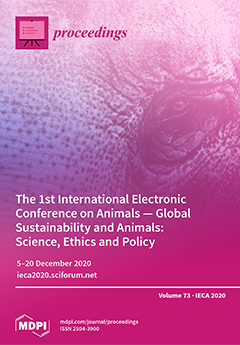Need Help?
Proceedings, 2021, IECA 2020
The 1st International Electronic Conference on Animals—Global Sustainability and Animals: Science, Ethics and Policy
Online| 5–20 December 2020
Volume Editor:
Clive J. C. Phillips, 1 Estonian University of Life Sciences, Estonia; 2 Curtin University, Australia
- Issues are regarded as officially published after their release is announced to the table of contents alert mailing list.
- You may sign up for e-mail alerts to receive table of contents of newly released issues.
- PDF is the official format for papers published in both, html and pdf forms. To view the papers in pdf format, click on the "PDF Full-text" link, and use the free Adobe Reader to open them.
Cover Story (view full-size image):
This volume presents a collection of the contributions made to the ”1st International Electronic Conference on Animals—Global Sustainability and Animals: Science, Ethics and Policy”
[...] Read more.
This volume presents a collection of the contributions made to the ”1st International Electronic Conference on Animals—Global Sustainability and Animals: Science, Ethics and Policy” that was held online on 5–20 December 2020. This conference provided a common platform for leading scientists working in the field of Animal Science to share and discuss their latest research and to promote the advancement of this exciting and rapidly changing field. The conference mainly covered the following topics: climate change and sustainability of animal systems; sustainability of animal use and demand for animal products; animal welfare, ethics, policy, and politics; animal health and sustainability; sustainable animal feeding.
Previous Issue
Next Issue
Issue View Metrics
Multiple requests from the same IP address are counted as one view.



